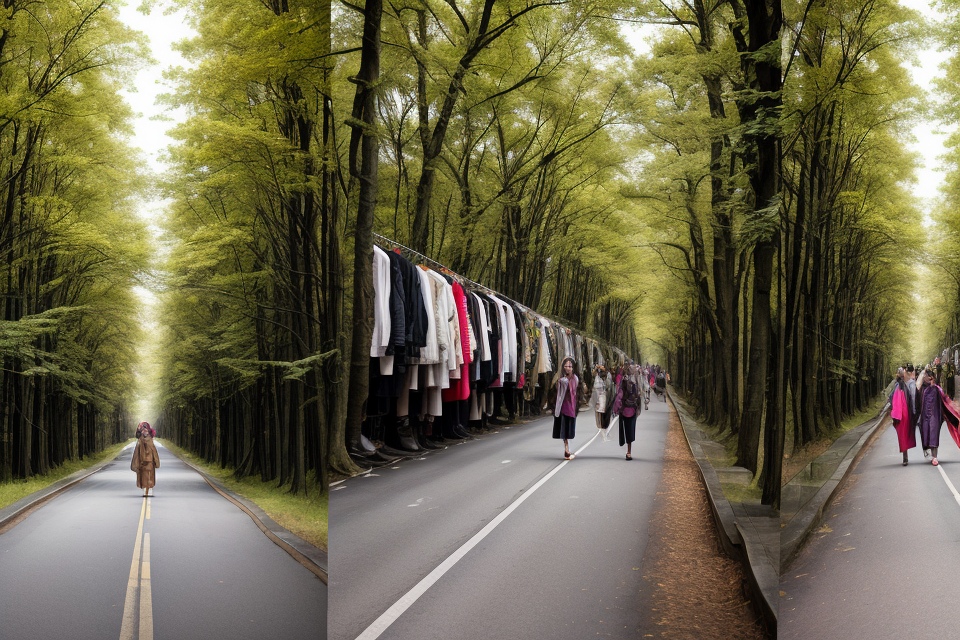
The fashion industry is a significant contributor to global pollution and waste, with its rapid production cycles and emphasis on fast fashion. However, there is growing awareness and demand for sustainable practices in the industry. Can the fashion industry achieve sustainability? This article explores the challenges and opportunities for sustainability in the fashion industry, including the role of consumers, designers, and technology in promoting sustainable practices. Join us as we delve into the world of sustainable fashion and explore the potential for a more environmentally-friendly industry.
The fashion industry has made progress towards sustainability in recent years, but there is still a long way to go. Some companies have implemented more environmentally friendly practices, such as using organic cotton and recycled materials, but the industry as a whole is still highly polluting and resource-intensive. Additionally, fast fashion, which is characterized by low-cost, quickly-made garments, has exacerbated the industry’s environmental impact. While there are some encouraging signs, such as the growth of the secondhand clothing market, it remains to be seen whether the fashion industry can fully embrace sustainability on a large scale.
The Current State of the Fashion Industry
The Fast Fashion Model
Environmental Impact
The fast fashion model has significantly contributed to the environmental crisis, primarily due to its reliance on rapid production and disposal of clothing. The industry is responsible for generating massive amounts of textile waste, with an estimated 92 million tons of textile waste being produced annually worldwide. The production of synthetic materials, such as polyester and acrylic, further exacerbates the problem by emitting harmful greenhouse gases during manufacturing. Moreover, the fast fashion model promotes a throwaway culture, encouraging consumers to buy more clothes, wear them briefly, and then discard them, leading to an exponential increase in landfill waste.
Economic and Social Impact
The fast fashion model has not only had detrimental environmental consequences but also economic and social implications. The low-cost and disposable nature of fast fashion garments has led to an oversaturation of the market, causing price deflation and putting pressure on manufacturers to cut costs. This has often resulted in exploitative labor practices, such as underpaying workers and failing to provide safe working conditions. Additionally, the fast fashion model has contributed to the homogenization of fashion trends, reducing the diversity of styles and choices available to consumers. This uniformity has had a profound impact on local and regional fashion industries, often pushing them to the brink of extinction.
Furthermore, the fast fashion model perpetuates a cycle of overconsumption, encouraging consumers to constantly purchase new clothing items, which in turn fuels the industry’s growth. This has led to a significant increase in the demand for raw materials, energy, and water, further straining already scarce resources. In summary, the fast fashion model has had far-reaching and devastating consequences on both the environment and society, making it clear that significant changes are needed in the fashion industry to achieve sustainability.
The Luxury Fashion Model
The luxury fashion model, which prioritizes high-end and luxury products, has a significant environmental impact. This model relies heavily on the use of non-sustainable materials, such as cotton, polyester, and leather, which require large amounts of water and energy to produce. The use of these materials also contributes to the production of harmful chemicals and waste.
Moreover, the luxury fashion model promotes overconsumption and fast fashion, which encourages consumers to purchase more clothing than they need and discard it quickly. This results in a large amount of textile waste that ends up in landfills and contributes to the fashion industry’s overall carbon footprint.
The luxury fashion model also has a significant economic and social impact. The high-end fashion industry is highly concentrated, with a few major brands dominating the market. This lack of competition results in limited opportunities for small and independent designers, who struggle to compete with the marketing budgets and brand recognition of larger brands.
Additionally, the luxury fashion model perpetuates a culture of consumerism and materialism, which contributes to social and economic inequality. The industry’s focus on high-end products and luxury materials perpetuates a cycle of waste and resource depletion, while excluding many people from accessing affordable and sustainable fashion options.
Overall, the luxury fashion model contributes significantly to the fashion industry’s environmental and social problems, and a shift towards more sustainable and equitable practices is necessary for the industry to achieve true sustainability.
The Challenges of Achieving Sustainability in Fashion
Environmental Challenges
Resource Depletion
The fashion industry relies heavily on natural resources such as water, energy, and raw materials. Cotton, for example, is one of the most resource-intensive materials used in the industry, requiring large amounts of water and pesticides to grow. Furthermore, the production of synthetic fibers such as polyester and nylon also consumes significant amounts of energy and chemicals.
Waste and Pollution
The fashion industry generates a tremendous amount of waste and pollution. Textile waste, which includes discarded clothing, fabric scraps, and worn-out garments, accounts for a significant portion of the waste generated by the industry. Additionally, the use of harmful chemicals in the production process can contaminate water sources and pose a threat to human health.
Supply Chain Complexity
The fashion industry has a complex and globalized supply chain, which makes it difficult to track and manage the environmental impact of each stage of production. This complexity also makes it challenging to ensure that sustainability standards are being met throughout the supply chain. Moreover, the fast-paced nature of the industry, with its focus on constant innovation and new designs, can lead to a lack of consideration for the long-term environmental impact of products.
Economic and Social Challenges
Business Model Dependence on Fast Fashion
One of the major challenges in achieving sustainability in the fashion industry is the dependence on fast fashion business models. Fast fashion refers to the practice of rapidly producing and selling low-cost clothing to meet the ever-changing fashion trends. This approach has led to overproduction, excessive waste, and environmental degradation. As a result, the industry is struggling to transition to a more sustainable model.
High Cost of Sustainable Practices
Sustainable practices in the fashion industry, such as using eco-friendly materials and reducing water usage, often come with a higher cost. This is because these practices require significant investments in research, development, and infrastructure. Additionally, sustainable materials are typically more expensive than traditional materials, which makes them less attractive to fashion brands looking to cut costs. This economic challenge makes it difficult for the industry to fully embrace sustainability.
Resistance to Change from Consumers and Industry Players
Consumers and industry players also pose a challenge to achieving sustainability in the fashion industry. Many consumers are resistant to change, preferring cheap and disposable clothing over more sustainable options. Additionally, some industry players are resistant to change due to a lack of understanding of the benefits of sustainability or a fear of losing market share. This resistance to change hinders the industry’s ability to adopt more sustainable practices on a large scale.
The Way Forward for Sustainable Fashion
Sustainable Practices in the Fashion Industry
Material Sourcing
The fashion industry can move towards sustainability by adopting responsible material sourcing practices. This involves selecting materials that are environmentally friendly, ethically sourced, and produced using sustainable methods. Some sustainable materials that are gaining popularity in the fashion industry include organic cotton, recycled polyester, and tencel. By choosing materials that have a lower environmental impact, fashion brands can reduce their carbon footprint and promote sustainable practices.
Production Processes
Sustainable production processes are crucial for achieving sustainability in the fashion industry. Brands can adopt eco-friendly practices such as reducing water usage, using renewable energy sources, and minimizing waste during production. One approach is to use a closed-loop system, where waste materials are recycled and reused in the production process. This reduces the amount of waste sent to landfills and promotes a circular economy. Additionally, fashion brands can adopt ethical labor practices by ensuring that workers are paid fair wages and working in safe and healthy conditions.
Waste Management
Waste management is another critical aspect of sustainability in the fashion industry. Brands can reduce their environmental impact by implementing recycling programs and encouraging customers to recycle their old clothes. They can also adopt a zero-waste approach by designing products that use minimal materials and can be easily repaired or upcycled. This reduces the amount of waste generated during production and encourages a more sustainable approach to fashion.
Labor Practices
Finally, sustainable labor practices are essential for promoting ethical and responsible fashion. Brands can ensure that their supply chains are transparent and free of exploitation by conducting thorough audits and engaging with suppliers who share their commitment to sustainability. They can also support fair labor practices by paying fair wages and providing safe and healthy working conditions for their employees. By promoting ethical labor practices, fashion brands can contribute to a more sustainable and equitable fashion industry.
Policy and Regulatory Initiatives
Government Initiatives
- Governments around the world are beginning to take notice of the environmental impact of the fashion industry and are implementing policies and regulations to encourage sustainable practices.
- For example, the European Union has implemented the Circular Economy Action Plan, which aims to promote sustainable production and consumption, reduce waste, and increase recycling and reuse.
- The United States has also introduced the Fashion Sustainability and Social Accountability Act, which requires fashion brands to disclose their supply chains and ensure that their products are made in a socially and environmentally responsible manner.
Industry Initiatives
- The fashion industry is taking steps towards sustainability by implementing their own policies and regulations.
- Many fashion brands have committed to using sustainable materials, reducing water usage, and reducing their carbon footprint.
- Some brands have also implemented take-back programs, where customers can return their old clothes for recycling or upcycling.
Consumer Initiatives
- Consumers can also play a role in promoting sustainability in the fashion industry.
- By making more conscious purchasing decisions, such as choosing brands that prioritize sustainability, consumers can encourage the fashion industry to adopt more sustainable practices.
- Additionally, consumers can extend the life of their clothing by repairing, repurposing, and upcycling, rather than disposing of them.
Overall, policy and regulatory initiatives, along with industry and consumer initiatives, can play a crucial role in promoting sustainability in the fashion industry. By working together, stakeholders can drive positive change and reduce the environmental impact of the fashion industry.
Collaboration and Innovation
Cross-Industry Collaboration
Collaboration is a crucial aspect of achieving sustainability in the fashion industry. The fashion industry is complex and encompasses various stages, from design and production to marketing and distribution. To achieve sustainability, the industry must work together to implement best practices and develop innovative solutions. Cross-industry collaboration involves partnering with other industries that have a stake in the fashion supply chain, such as textile manufacturers, retailers, and technology companies. By working together, the industry can develop a holistic approach to sustainability that addresses the environmental, social, and economic aspects of fashion.
Technological Innovation
Technological innovation is another important aspect of achieving sustainability in the fashion industry. Technology can help reduce the environmental impact of fashion by enabling more efficient and sustainable production processes. For example, digital design tools can reduce waste by allowing designers to create virtual prototypes before producing physical samples. Additionally, technologies such as 3D printing and laser cutting can minimize material waste and create more efficient patterns. Moreover, technology can help track and trace the supply chain, ensuring transparency and accountability throughout the production process.
Circular Economy Models
A circular economy model is an approach to sustainability that emphasizes the reuse and recycling of materials. In the fashion industry, this involves designing products that can be easily disassembled and recycled at the end of their life cycle. It also involves exploring alternative materials that are more sustainable and recyclable, such as organic cotton and recycled polyester. A circular economy model can help reduce the environmental impact of fashion by minimizing waste and maximizing the use of resources. Additionally, it can create new business opportunities and revenue streams, such as resale and rental programs, that promote sustainability and circularity.
The Role of Consumers in Achieving Sustainability in Fashion
Education and Awareness
Education and awareness are crucial in shaping consumer behavior and fostering a more sustainable fashion industry. By increasing knowledge about the environmental and social impacts of fashion, consumers can make informed choices that promote sustainability. This includes understanding the importance of materials, production processes, and supply chains, as well as the long-term consequences of fast fashion and overconsumption.
Mindful Consumption
Mindful consumption involves being aware of the impact of one’s actions on the environment and society. In the context of fashion, this means considering the following aspects:
- Needs vs. wants: Purchasing items only when they are truly needed or will be frequently used, rather than impulsively or out of boredom.
- Quality over quantity: Opting for well-made, durable garments that can withstand repeated wear and washing, reducing the need for frequent replacements.
- Secondhand and vintage: Embracing the circular economy by buying secondhand or vintage clothing, which extends the life cycle of garments and decreases the demand for new, resource-intensive products.
- Slow fashion: Supporting brands that prioritize quality, sustainability, and ethical practices, rather than following fast fashion trends that prioritize speed and low cost.
Advocacy and Activism
Consumers can advocate for sustainability in fashion by engaging in activism and supporting organizations that promote change in the industry. This includes joining campaigns, signing petitions, and attending events that raise awareness about environmental and social issues in fashion. Consumers can also use their social media platforms to spread awareness and encourage others to adopt more sustainable practices.
Supporting Sustainable Brands and Initiatives
Supporting sustainable brands and initiatives is a powerful way for consumers to drive change in the fashion industry. By choosing to purchase from brands that prioritize sustainability, consumers send a strong message to the industry that there is a demand for more ethical and environmentally friendly practices. Additionally, supporting initiatives such as clothing recycling programs, upcycling, and textile waste reduction initiatives can help create a more circular and sustainable fashion ecosystem.
In conclusion, the role of consumers in achieving sustainability in fashion is crucial. By adopting mindful consumption, advocating for change, and supporting sustainable brands and initiatives, consumers can play a significant role in shaping the future of the fashion industry and promoting a more sustainable and equitable society.
FAQs
1. What is sustainable fashion?
Sustainable fashion refers to the production and consumption of clothing, footwear, and accessories that are produced with minimal impact on the environment and with consideration for the well-being of people and animals. It aims to reduce waste, pollution, and energy consumption throughout the entire supply chain, from sourcing materials to disposing of products.
2. Is the fashion industry sustainable?
The fashion industry is not currently sustainable. It is one of the most polluting industries in the world, responsible for significant environmental damage, including water pollution, soil degradation, and greenhouse gas emissions. Additionally, the fast fashion model, which emphasizes rapid production and consumption, has contributed to overconsumption and waste.
3. Can the fashion industry be sustainable?
Yes, the fashion industry can be sustainable. However, achieving sustainability in the fashion industry will require significant changes in the way that clothing, footwear, and accessories are designed, produced, and consumed. This will involve using more sustainable materials, reducing waste and energy consumption, and improving working conditions for garment workers.
4. What is being done to make the fashion industry more sustainable?
There are a number of initiatives underway to make the fashion industry more sustainable. For example, some fashion brands are working to use more sustainable materials, such as organic cotton and recycled polyester, and to reduce their carbon footprint by using renewable energy sources. Additionally, there are efforts to improve transparency in the supply chain and to promote fair labor practices.
5. How can I make a difference in the fashion industry?
There are a number of ways that individuals can make a difference in the fashion industry. Some options include:
* Buying high-quality, timeless pieces that can be worn for a long time
* Supporting sustainable fashion brands and designers
* Upcycling and repurposing old clothes
* Donating or selling unwanted clothes
* Participating in clothing swaps with friends and family
* Educating oneself about sustainable fashion and sharing information with others.


